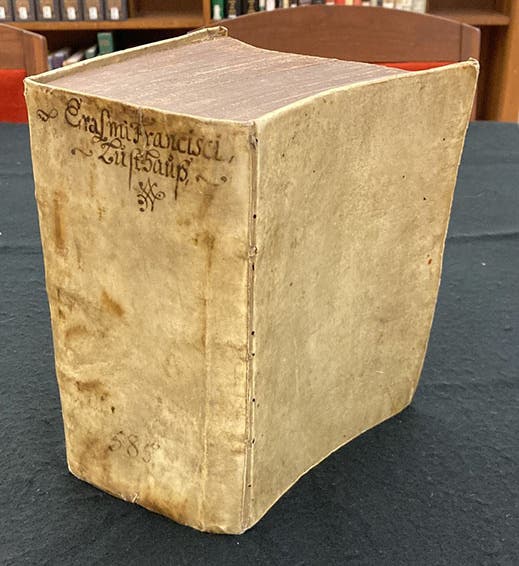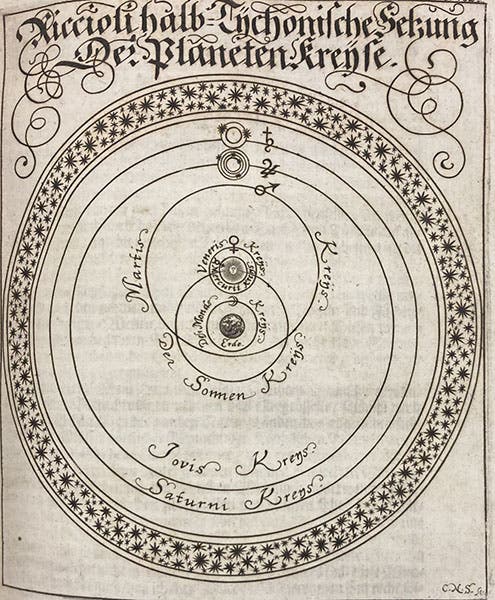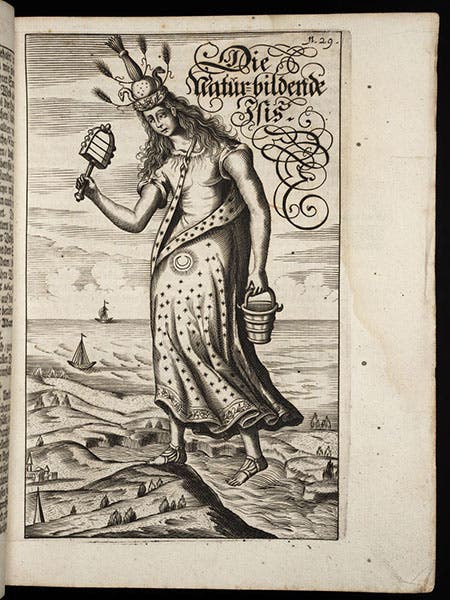Scientist of the Day - Erasmus Francisci
Erasmus Francisci, a German encyclopedist, was born Nov. 16, 1627, in Lübeck. He studied law, like his father, and worked for a while as a tutor, but it wasn't until he was laid up with a broken leg in Nuremberg that he stated writing works of a popular nature for the Nuremberg publisher and bookseller Johann Andreas Endter and his son Wolfgang. Francisci’s works sold well, the Endters were happy, and it would appear, from the number of his publications, that Francisci never stopped writing until his death in 1694 at age 67.
We have in our history of science collections just one book by Francisci, Das eröffnete Luft-haus der Ober- und Wieder-Welt (The Gazebo Opened to the Higher and Lower Worlds, 1676), but it is a doozy. It could have been a four-volume work in the hands of a different binder, but our copy is a single vellum-bound octavo volume of impressive thickness (first image). The book, in spite of its strange title (of which we will say more below), is mostly about astronomy, very similar in content to the Almagestum novum (1651) of Giambattista Riccioli, in that was written for a non-professional audience and attempted to be as up-to-date as possible in discussing such matters as possible world systems (cosmology) or the appearance of the Sun or Saturn or the faces of Jupiter and Mars as seen through a telescope. Written in German and printed in a black-letter font, the text presents a formidable obstacle to those not experienced with 17th-century German books. Fortunately, it contains many engravings, some of them quite handsome, which allow us to make some judgments about the contents.
One thing that quickly becomes apparent is that most of the illustrations were derived from other books, especially those of the Jesuit encyclopedists such as Riccioli or Athanasius Kircher. Francisci illustrated six different cosmologies, the familiar Ptolemaic, Copernican, and Tychonic systems (third image) that one normally sees, plus three more. But they are the exact same six systems that we can find in Riccioli’s Almagestum novum, including Riccioli’s own modified Tychonic system (fourth image). But I will say, the engravings of the six systems in Francisci’s book are much more decorative and handsome than those of Riccioli.
Kircher's Mundus subterraneus (1665) was the source for Francisci’s engraving of the surface of the Sun “according to Christoph Scheiner”; he had it copied exactly, which means it was too big for his book, and had to be folded, the only folded plate in the volume (fifth image). But Francisci was also familiar with the Philosophical Transactions of the Royal Society of London, for he copied the engravings printed there (1666) of the faces of Jupiter and Mars (sixth image) by Giovanni Domenico Cassini and Robert Hooke. And Francisci clearly knew Christiaan Huygens’ Systema saturnium (1659), where Huygens revealed that Saturn has a ring, for Francisci copied not only two of Huygens’ plates that showed the changing appearances of Saturn, but also Huygens’ engraving of the Great Nebula of Orion (seventh image)
Francisci included in his introduction two engravings that show personifications of Nature, one according to the Greeks, depicting the multi-breasted Artemis of Ephesus, and the other showing the Egyptian Nature goddess Isis. I include the latter (eighth image), for it is unusual, and although it is probably copied from somewhere, I do not know the source. I am guessing it came from an iconology, such as Cesare Ripa's Iconologia (1593), which had many editions in the 17th century.
For our final image, we show the engraved title page of Francisci’s book, for it sheds light on the odd title (ninth image). We see the garden house in the background, the zodiac and an eclipse-in-progress in the heavens, and an array of seven statues on the terrace, who represent at once the seven planets in the higher world (the macrocosm) and the seven metals of the lower world (the microcosm). A helpful putto brings the eclipse down to earth by reflecting it in a tub of water. The “two worlds” is a familiar trope in Renaissance magic, and it was used for the title of Robert Fludd’s great work on natural magic (Utriusque cosmi maioris scilicet et minoris metaphysica, History of the Macrocosm and Microcosm, 1617-19), but it seems odd for Francisi’s book, for the work is all about the macrocosm, and little attention was paid to any microcosms, whether the Earth or the human body. Perhaps he wrote a separate book about the lesser world that I have not run across. Or perhaps his book just got so fat that the Endters cried: “Enough!”
William B. Ashworth, Jr., Consultant for the History of Science, Linda Hall Library and Associate Professor emeritus, Department of History, University of Missouri-Kansas City. Comments or corrections are welcome; please direct to ashworthw@umkc.edu.















